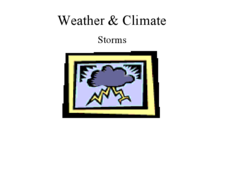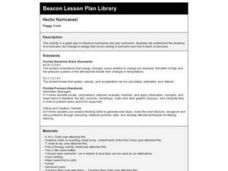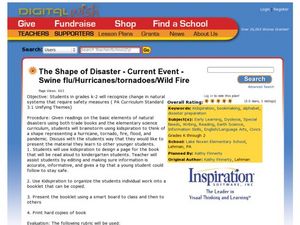Curated OER
Hurricane and Tornadoes Vocabulary
Quiz your young meteorologists using this simple matching learning exercise. Learners inventory 16 weather-related terms, matching them to the appropriate definition on the right. There are an equal number of definitions as there are...
Curated OER
Coastal Weather Issues: Planning for a Hurricane
Seventh graders utilize internet resources to gather, analyze, and interpret hurricane data. They develop a public information booklet that be used as a guide for the community to use when preparing for a hurricane.
Curated OER
Weather and Climate: storms
The main types of storms are described in this presentation and characteristic facts are given. The main details thunderstorms, tornadoes, hurricanes and winter storms formations are listed. Geographical features that affect weather...
Walt Disney Company
Disaster Preparedness Activity Book
Join the American Red Cross as well as Mickey and friends as they help to prepare young scholars for natural disasters. After reading brief informational passages about earthquakes, floods, fires, storms, tornadoes, and hurricanes,...
Curated OER
The Effects of Storms
An excellent way to review a chapter or unit on storms, this worksheet features vocabulary review (gust, evacuation, storm surge, salinity), concept review (effects and details about hurricanes), skills/process review (normal high tide...
Curated OER
Eye on the Storm
Students discover the way geologists collect information about past hurricanes to determine patterns that may help with storm prediction. They then research the history of natural disasters in different regions of the United States and...
Curated OER
Learning About Weather
First graders investigate natural weather disasters by writing an essay. In this weather activity, 1st graders research one aspect of dangerous weather such as hurricanes, snow, floods, etc. Students take notes on their...
Curated OER
Storm Seekers
Young scholars explore storms and compare the similarities and differences of hurricanes and tornadoes through the use of a Venn diagram. They conduct interviews as part of their research into the myths and legends of storms.
Curated OER
Stronger Hurricanes
Students explore hurricanes, the factors that contribute to them, and the role warmer sea surface temperatures may have on them. They perform experiments to observe energy transfer. Students explore the possible causes and effects of...
Curated OER
Hectic Hurricanes!
Students determine what they know about hurricane formation. They experiment to explain hurricane formation and track a hurricane that forms in the Caribbean Islands.
Federal Reserve Bank
Natural Disasters: From Destruction to Recovery
What are the major economic implications, both good and bad, of natural disasters? Discover the effect that natural disasters can have on labor market conditions, capital, household incomes, and opportunities for reconstruction in local...
Curated OER
Where is Everyone Going?
Students conduct an experiment. In this emergency response lesson, students watch videos about hurricanes and discuss the difference between natural disasters and man-made disasters. Students perform a hurricane demonstration and...
Curated OER
What are Natural Disasters?
There are several types of natural disasters: quakes, floods, avalanches, and more. This slide show gives a brief explanation of each at an elementary-aged child's level. There are no frightening photos from actual natural disasters,...
Curated OER
Storms and Extreme Weather
Learners explore hurricanes and tornadoes by conducting an experiment. In this weather pattern activity, students define many extreme weather vocabulary terms and discuss the relationship with static electricity. Learners utilize plastic...
Curated OER
Survival Experts
Students take on the role of survival experts as they research and produce brochures or guides to educate others about what to do in the event of a natural disaster.
Curated OER
Natural Disaster Blooms Taxonomy
Students complete activities that lead to greater understanding of the variety of natural disasters that occur all over the world.
Curated OER
Naturally Disastrous
Young scholars examine the types and effects of natural disasters. In this natural disaster lesson, students study the different types of natural disasters including; avalanches, earthquakes, floods, hurricanes, and tornadoes. They...
Curated OER
Blowing in the Wind
Students compare hurricanes and tornadoes. They write a paragraph explaining how to prepare for a storm. Students give an oral report. They use weather facts to practice math skills. Students record observations of a storm.
Curated OER
The Wind and Its Origin
Students discuss the wind and how it feels. Using talcum powder and a lamp, students participate in an activity where they observe spirals in the air. They discover the causes of wind and how hot air rises and cold air sinks.
Curated OER
Natural Disasters
Ninth graders write a description of a natural disaster. They list as many natural disasters as they can think of. The class discusses any natural disasters individuals have witnessed first hand. They watch a brief clip of a film that...
British Council
Weather 2
Young meteorologists answer questions based on the types of weather they experience in the region they live. They also complete a word search to find weather-related terms.
Center Science Education
Weather in the News
Tornadoes, blizzards, and hurricanes, oh my! In this lesson, meteorology majors compare stories of historical storms written by two or more different sources. As a result, they understand how the media portrays such catastrophes and...
Curated OER
The Shape of Disaster - Current Event- Swine Flu/Hurricanes/Tornadoes/Wild Fire
Students create a disaster preparation book. In this disaster preparation lesson, students research disasters and use the kidspiration program to create a shape to represent each disaster. They create a page for each disaster.
Curated OER
Do The Research! Forces of Nature
For this researching forces of nature worksheet, students read and record information about tornadoes, hurricanes, and the largest hailstones. Students write 3 short answers.

























